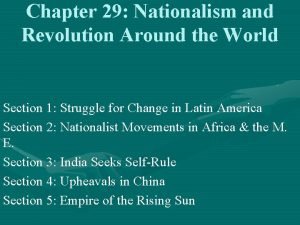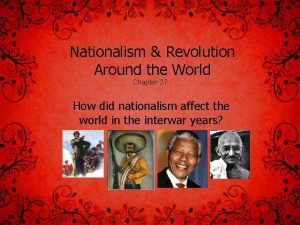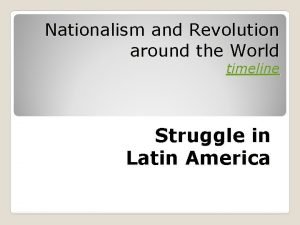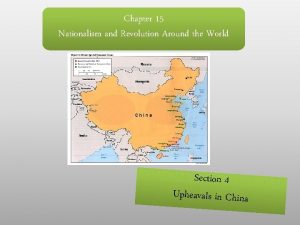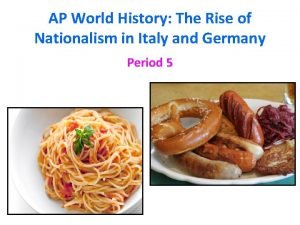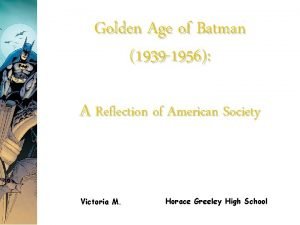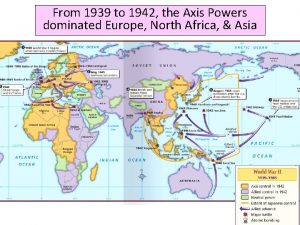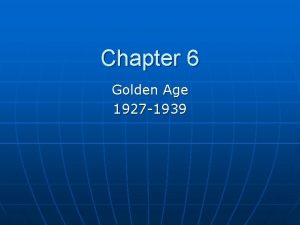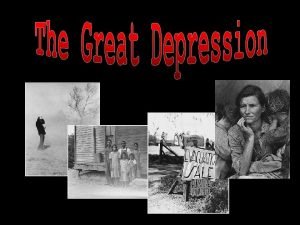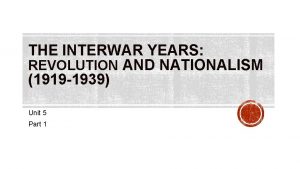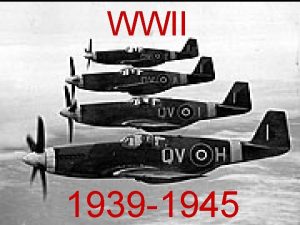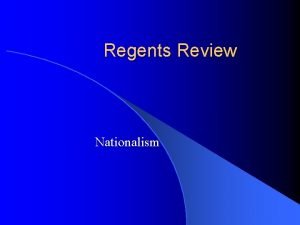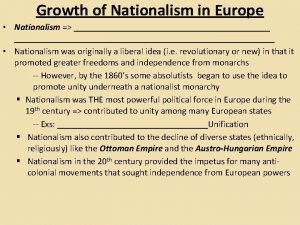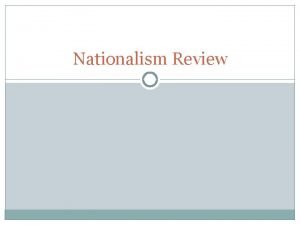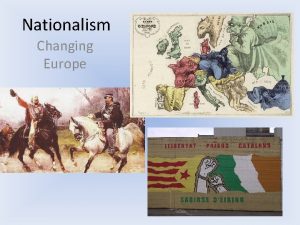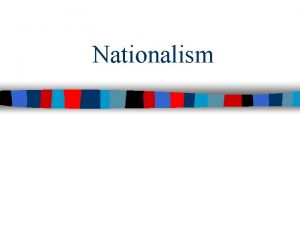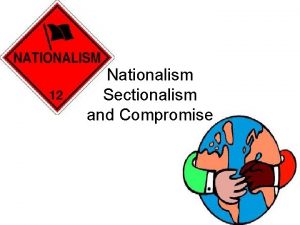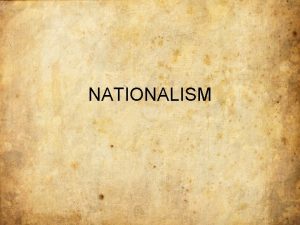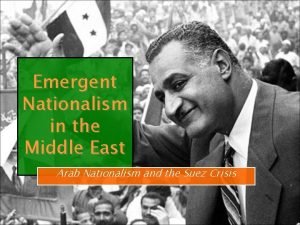Nationalism Around the World 1919 1939 The Middle



















- Slides: 19

• Nationalism Around the World 1919 -1939 – The Middle East • A. World War I Legacy – 1. Breakup of Ottoman Empire led to major changes in the map of Middle East and renewed conflicts over borders and authority » a. Armenian Genocide (***1896) 1915 -1918 Turks and Kurds killed an estimated 1 million Armenian Christians and deported thousands more from their villages during and after WWI due to their “support for Russia”



• B. Modernization of Turkey Under the Young Turks – 1. 1908 -1023 efforts for Turkish nationalism and removal of traditional monarchy (sultanate) in favor of establishing a republic – 2. Short war against Greece 1921 -1923 led to the popularity of Colonel Mustafa Kemal Ataturk who would become the new Turkish president » a. Promoted rapid industrialization, “de-Arabized” Turkish culture, limited democracy, and secular government » b. While not popular amongst all Turks, his legacy in creating a modern, stable nation in the Middle East after WWI is significant

• C. Modernization of Iran (Persia) Under Shah Reza Pahlavi – 1. Fall of Qajar Dynasty 1925 led to military coup d’etat and attempts by new monarch to reform, modernize, and strengthen the weak Persian state – 2. Renamed Iran in 1935, Pahlavi promoted westernization of schools, culture, and economics – 3. The Shah would grow close with Nazi Germany in the late 1930 s and Britain, Soviet Union, and U. S. would help replace him with his son Mohammed Reza Pahlavi in 1941 – 4. Iranian society would struggle with issues of Westernization, dictatorship, and economic disparities over the decades leading up to the Islamic Revolution of 1979


• D. Arab Nationalism Hindered by WWI? – 1. Goals for a wide reaching Arab nation were negatively affected by a League of Nations decision to establish British and French mandates due to confusion over Arab leadership and borders – 2. Saudi Arabia established its independence in 1932 under the King Abdul-Aziz Ibn Saud – 3. Jordan, Iraq, Syria, Lebanon, Egypt, and Palestine remained under combined British and French control – 4. Palestine Issue Complicated Matters- Zionism vs. Arab Nationalism » a. 1917 Balfour Declaration indicated British Parliamentary support for a Jewish state which contradicted 1916 British support for an Arab state


• II. Nationalism in Africa and Asia – A. African Colonial Protests • 1. 1920 s- Numerous movements for independence from Britain, France, Belgium arose after WWI due to desires for national identity and national freedom – a. Nigeria, Kenya, Libya, South Africa, etc. – 2. Some movements were violent while others were peaceful and used the power of the press through newspapers and lobbying European governments for change

• 3. African National Congress (established in 1912) continued to pursue justice and equality for nations under foreign rule across the African continent and policy of Pan-Africanism • 4. Key African leaders mixed traditionalism with modernism and promoted unity of people toward common goals throughout 1930 s, 40 s, 50 s, 60 s – a. Nelson Mandela, Harry Thuku, Jomo Kenyatta

– B. Indian Nationalism • 1. Indian National Congress formed in 1885 to promote Indian Independence Movement • 2. Leaders Mohandas Gandhi, Jawaharlal Nehru, and Mohammad Ali Jinnah often disagreed on the course of the movement and means of achieving goals for India

• 3. Gandhi became figure head for the movement due to both his modern intellectual abilities and his ability to relate to traditional Indians who were suffering under British rule – a. Mahatma- “great soul” given as name for Gandhi due to his level of self-sacrifice and commitment to the well-being of the Indian people • 4. Civil Disobedience- use of non-violent tactics to intentionally break unjust laws/policies to bring about change – Ex. Homespun Boycott, Salt March, Hunger Strikes • 3. Jinnah and the Muslim League eventually called for creation of separation of Muslim Pakistan from Hindu India which complicated the nationalist movement in the 1930 s

• III. Nationalism in East Asia – A. Japan’s Militarism and Expansion • 1. Meiji Era (1870 s) to Taisho Period (1920 s) brought about heightened level of government-industrial-military relationship • 2. Zaibatsu- large corporations that controlled major segments of banking, manufacturing, insurance – Ex. Mitsubishi, Toyota, Yamaha • 3. Conservative Japanese leaders demanded that cooperation with Western powers stop and that Japan take control of its own affairs – – a. 1 st Sino-Japanese War 1894 b. Russo-Japanese War 1905 c. Korean Annexation 1908 d. 2 nd Sino-Japanese War 1931

– 5. Extremist political parties promoted the ideology of the Japanese race as superior to all (Black Dragon Society) • B. China’s Revolution Turns To Civil War – 1. 1920 - central government was failing due to competing factions of Guomindang Nationalists, the Chinese Communist Party, and numerous regional generals – 2. Temporary truce between Sun Yat-Sen’s Guomindang and the CCP was destroyed after his death – 3. Shanghai Massacre 1927 - Guomindang leader Chiang Kai-Shek attacked CCP and attempted to establish control over Chinese government from Nanjing – 4. Mao Zedong’s CCP went into hiding, formed the People’s Liberation Army, and used guerrilla tactics to undermine Chiang Kai-Shek’s government • a. Long March 1934 - Struggling PLA was able to avoid total annihilation by Nanjing forces and slowly gained popularity through living among the peasants and promising them a better future through communism

• 5. Chiang Kai-Shek’s Republic continued to struggle through the 1930 s due to numerous reasons – a. Public dislike for leader – b. Gaps between rich and poor – c. Divide between rural and urban people – d. Illiteracy of population – e. Public opposition to “Western” style of government – f. Lack of land reform and redistribution of wealth

• IV. Nationalism in Latin America – A. Great Depression and Latin American Economy • 1. Largely agricultural and export-based economy was negatively impacted by the global depression of the 1920 s and 1930 s • 2. Latin American citizens resented U. S. influence over industries in their respective countries and saw the U. S. as an “economic imperialist” – Ex. Oil, Fruit, Railroads, Shipping, Mining, Panama Canal

– B. Authoritarian Regimes Emerge in the 20 th Century • 1. Causes: military officials saw strict government as the only effective means of combating Marxism in Latin American countries • 2. Caudillos: military strongmen who made key promises of preserving stability which appealed to wealthy and poor people alike through patriotism – a. Juan Peron in Argentina 1943 -1973 – b. Getulio Vargas in Brazil 1930 -1945 – c. Lazaro Cardenas in Mexico 1934 -1940

• 3. Caudillos were known for one-party rule, censorship of media, torture, execution IN ADDITION to nationalizing major industries and bringing businesses under government control – Ex. PEMEX- oil and gas company in Mexico – C. Latin American Public Sentiment Grew Anti. American • 1. Critiques of U. S. emerged due to American support for caudillos in the 1940 s and 1950 s

 Chapter 29 nationalism around the world answers
Chapter 29 nationalism around the world answers Nationalism and revolution around the world
Nationalism and revolution around the world Nationalism and revolution around the world
Nationalism and revolution around the world Nationalism and revolution around the world
Nationalism and revolution around the world Nationalism in africa and the middle east
Nationalism in africa and the middle east What goes around comes around example
What goes around comes around example Goes around comes around meaning
Goes around comes around meaning Nationalism ap world history
Nationalism ap world history Ap world history
Ap world history Selected population pyramids in the united states
Selected population pyramids in the united states 1930-1939 fashion
1930-1939 fashion Revolutionary leaders 1900-1939
Revolutionary leaders 1900-1939 Poland population 1939
Poland population 1939 Varför kallas perioden 1918-1939 för mellankrigstiden
Varför kallas perioden 1918-1939 för mellankrigstiden The golden age (1939-1956)
The golden age (1939-1956) Harta germaniei
Harta germaniei Goodguysww.
Goodguysww. Golden age of aviation 1927-1939
Golden age of aviation 1927-1939 1939 market crash
1939 market crash Mapamundi 1939
Mapamundi 1939
